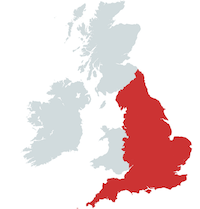
Map by mapchart.net - Some rights reserved.
Location
Conisbrough, South Yorkshire, England
Description
Conisbrough Castle is located in the town of Conisbrough near Doncaster, South Yorkshire, England. The most impressive feature of the ruins is the hundred foot high circular keep supported by six buttresses giving it a star shaped cross section - it is one of the finest and most unusual Norman keeps in England. The keep is at the eastern side of a central courtyard surrounded by a curtain wall. The southern part of the wall has now collapsed. The gateway is on the south side of the courtyard. Along the north side of the courtyard are remains of a number of buildings including the Great Hall, buttery, kitchens and bake house. Along the east side of the courtyard are the remains of the accommodation blocks and the Great Chamber.
Restoration work on the keep commenced in 1992, and a wooden roof and internal floors were rebuilt. The castle re-opened to the public in 1995. The castle now has a visitors centre with audio visual displays. Conisbrough Castle is one of South Yorkshire's main tourist attractions. It 1988 operation of the site was taken over by The Ivanhoe Trust under a management agreement between English Heritage and Doncaster Council who own the land. In April 2008 day-to-day operation of the site was handed back to English Heritage.
History
The first castle on the site was built by William de Warenne, the first Earl of Surrey (son-in-law of William the Conqueror). The original castle was probably a motte and bailey design built around 1070. The present castle was built by Hamelin Plantagenet, the fifth Earl Warenne. The cylindrical stone keep of the castle was built around 1180. King John, the nephew of Hamelin, stayed at the castle in 1201. The stone curtain walls were built not long after the keep. The other stone buildings within the bailey may been added in the early 13th century.
The Warenne ownership of the castle ended with John was thus the eighth and last Earl Warenne, when it was seized by Thomas, Earl of Lancaster in 1316 in retaliation for Earl John abducting Lancaster's wife Alice. Lancaster did not last long in Conisbrough, though - in 1322 he led a rebellion against the King Edward II. Lancaster was captured and found guilty of treason, then executed outside the walls of his castle at Pontefract. Conisbrough was then held by Edward II until 1326 when it was handed back to John de Warenne in 1326 and died heirless in 1347. Conisbrough reverted to the Crown and Edward III conferred the estate on his youngest son Edmund and his family who held it until 1446. The castle then passed to Richard Duke of York, then to his son who in 1461 became Edward IV.
By the end of the 15th century, Conisbrough was falling into disrepair. By the time of Henry VIII, records from 1538 show that the gates of the castle, the bridge, and about 55m of wall between the tower and the gate had collapsed, and one floor of the keep had fallen in. The remains of the castle were granted by Henry VIII to the Carey family. During the Civil War of the seventeenth century (1642-1651) when many other English castles were destroyed or damaged, Conisbrough Castle was left untouched because the gate and walls had already partly collapsed.
It was bought by Conisbrough local council in the 1940s, and is now in the care of English Heritage.
The Arts
"Coningsburgh Castle" in the Sir Walter Scott novel, Ivanhoe, is based on Conisbrough Castle.
|
|
|
|

